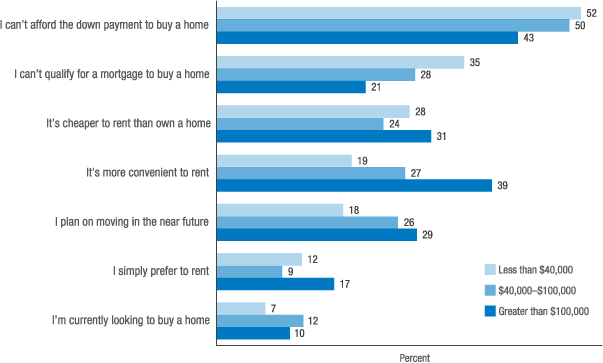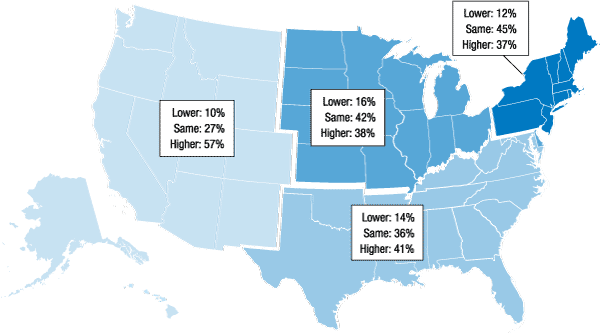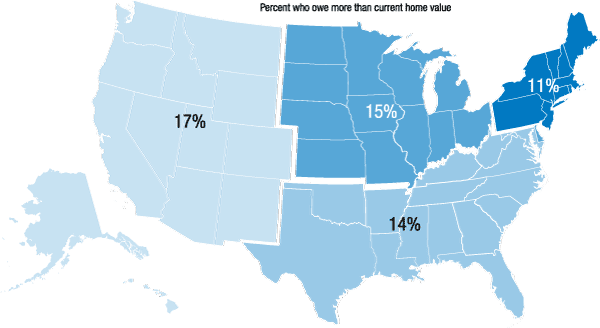Report on the Economic Well-Being of U.S. Households in 2014
- Preface
- Executive Summary
- Introduction
- Overall Economic Well-Being
- Housing and Household Living Arrangements
Housing and Household Living Arrangements
Housing represents one of the largest expenses in most families' financial picture and, as such, one's housing situation is closely tied to economic well-being. Partially reflecting the level of resources necessary to purchase and maintain a home, respondents who own their home are more likely to report that they are either "doing okay" or "living comfortably" (74 percent) than those who rent (48 percent).
Recognizing the importance of housing to one's overall well-being, the SHED poses a series of housing-related questions to survey participants. The survey finds that most renters express a preference for homeownership, but despite this preference, many renters report that financial barriers prevent them from purchasing a home. The survey results also illustrate that while some homeowners are underwater on their mortgage, in general those who own a home are optimistic that the value of their home is increasing and that home values will continue to appreciate in the near future.
Living Arrangements
The vast majority of respondents (80 percent) report that they either live alone or only with their immediate family members, while 10 percent of respondents live with their parents and 5 percent live with a roommate (table 6).
Of the respondents who live with someone outside of their immediate family, 64 percent say that they are either doing so to save money or to provide financial assistance to those who are living with them. However, about one out of every seven respondents who is living with someone outside of their immediate family indicates that they are doing so, at least in part, because of caregiving activities, with 12 percent reporting that they are caring for a sick, disabled, or elderly family member or friend, and 2 percent saying that they are either doing so to provide assistance with childcare for a child not their own or to receive assistance with childcare from others. Those with an income below $40,000 are nearly twice as likely to indicate caregiving activities as a reason for living with someone other than their immediate family compared to those whose household income is above $100,000 (19 percent versus 11 percent, respectively).
| Percent | |
|---|---|
| Living alone or only with your immediate family | 80.1 |
| Living with your parents | 9.7 |
| Living with roommate(s) | 4.7 |
| Living with your extended family | 3.0 |
| Living with your adult children | 2.4 |
| Total number of respondents | 5,896 |
Renters
Sixty-one percent of survey respondents report that they own their home, while 28 percent rent, and 10 percent neither own their home nor pay rent.
Among respondents who rent their home, the average renter pays $808 in monthly rent, while the median renter pays $700. The median rent is unchanged from the 2013 survey, while the mean rent is down from $852 in 2013.
When asked about their preference between owning and renting, 81 percent of renters indicate that they would prefer to own their home if they could afford to do so. Renters are also asked why they do not own their home, with the most common responses being that they cannot afford a down payment to buy a home (50 percent) or that they cannot qualify for a mortgage (31 percent). This suggests that perceived financial and credit barriers to homeownership are a crucial driver of why some individuals are renting rather than owning, despite the stated preference of many renters for homeownership.
On the other hand, while some respondents indicate that they rent due to an inability to qualify for a mortgage or afford a down payment, others indicate that they rent due to specific benefits of renting. In particular, 27 percent of renters say that they find it cheaper to rent than own, 25 percent say that they find it more convenient to rent, and 12 percent say that they simply prefer to rent. Nine percent of renters report that they are currently looking to buy a home. (Box 2 examines the relationship between motivation for renting and actual changes in homeownership status.)
The reasons that respondents cite for why they rent rather than own their home vary by income level (figure 3). Renters making under $40,000 are disproportionately likely to indicate that they rent due to the financial barriers to homeownership, with 35 percent reporting that they can't qualify for a mortgage and 52 percent reporting that they can't afford the down payment. In contrast, renters with an income over $100,000 are disproportionately likely to report that they rent due to personal preferences, including because it is more convenient to rent (39 percent), because they plan on moving in the near future (29 percent), or because they simply prefer to rent (17 percent).
Reasons for renting also differ by age in several notable ways. Among renters, those ages 18 to 29 are more likely to state that they plan on moving in the near future (36 percent) or that they are currently looking to buy a home (13 percent) than those in older age groups. Respondents over age 60 are most likely to indicate that they rent because it is cheaper to rent than to own (35 percent) or that they simply prefer to rent (26 percent).

Note: Among respondents who rent their home.
Return to textBox 2. Changes in Homeownership among Re-Interviewed 2013 Survey Respondents
Because a subset of survey respondents also participated in the 2013 SHED, it is possible to observe how responses change from one year to the next as well as to track how current responses match up with earlier expectations of future behavior. For instance, the 2013 survey asked respondents who were currently renting why they rented, and 10 percent reported that they were currently looking to buy. Since the 2014 survey asks respondents whether they now own their home and when they purchased, it captures the homeownership outcomes for respondents who, in 2013, said that they were planning to buy a home. Of respondents who were renting in 2013 and said that they were looking to buy, one-third actually did so. In comparison, only 3 percent of respondents who were renting in 2013 and did not say that they were looking to buy subsequently purchased a home in the intervening year.
Similarly, the panel nature of the survey allows for a comparison of the reason for renting among respondents who now rent but who owned a home in the previous year's survey. While just 9 percent of all renters in the 2014 survey say they are currently looking to buy a home, 26 percent of renters who owned a home in 2013 say they are currently looking to buy. This suggests that a sizeable fraction of respondents who transitioned recently from owning to renting view it as a temporary state. Renters who previously owned are also less likely to say that it is more convenient to rent (17 percent) or that they cannot afford the down payment on a house (22 percent) than are renters who did not previously own.
Return to textHomeowners
Among homeowners, 61 percent currently have a mortgage, and among mortgage holders the average monthly mortgage payment is $1,344, with a median payment of $1,068. The average tenure of homeowners is 15 years, while the median tenure is 12 years.
When asked why they own rather than rent, 44 percent say that they own because it allows them to build equity with their payments, 41 percent say that they feel that it is cheaper to own than to rent, and 20 percent like the certainty it provides for their monthly payments. Altogether, 67 percent of respondents cite at least one of these three financially motivated reasons for owning. However, many owners cite non-financial benefits as important considerations. Seventy-two percent of respondents say that they simply prefer to own, 43 percent say they own because there are fewer rules and they can customize their house, and 23 percent indicate that own because they do not like to move. Altogether, 83 percent of respondents cite at least one of these three non-financial motivations for owning.
Looking at the trend in home values, a plurality of homeowners believe that the value of their home increased in the 12 months prior to the survey. When asked to compare the current value of their home to the value one year prior (in fall 2013), 13 percent of homeowners say that the value of their home is now lower, while 37 percent say that the value has stayed the same and 43 percent say that their home now has a higher value. Respondents in the western region of the United States are the most likely to think that their home increased in value over this period, whereas those in the Northeast and Midwest are the least likely to think that their home value has appreciated (figure 4).
Figure 4. Compared to 12 months ago, do you think the value of your home today is higher, lower, or stayed the same? (by region)

Note: Among respondents who have owned their home since at least 2012.
Return to textMost homeowners also express optimism about the trajectory of home prices going forward. Just 6 percent of homeowners believe that home prices in their neighborhood will decline in the year after the survey, compared to 39 percent who expect home prices to rise. Optimism about future home prices is also highest in the western region of the United States, where half of respondents expect home prices in their neighborhood to rise, compared to 5 percent who expect home prices to fall.
Perceptions of the trajectory of home prices also vary by income, with only 28 percent of homeowners making under $40,000 per year expecting rising home values in their neighborhood, whereas 51 percent of those making over $100,000 have similar expectations. These results might reflect actual differences in the expected trajectory of home values by neighborhood, or might simply reflect a broader optimism about the path of the economy that is generally projected by higher-income respondents.
Seventy percent of homeowners with a mortgage report that the current value of their home exceeds the amount of their mortgage. However, 14 percent of mortgage holders report currently owing more than what their home is worth. Mirroring the findings for the perceptions of recent home prices, those in the West (17 percent) are most likely to state that they owe more than the value of their home. Those in the Northeast (11 percent) are the least likely to indicate that they are underwater on their mortgage (figure 5). The survey results also suggest that lower-income households are more likely to be underwater on their mortgage, with 20 percent of mortgage holders whose income is under $40,000 indicating that they owe more than their home is worth. This compares to 16 percent of those with incomes between $40,000 and $100,000 and 11 percent of those with incomes over $100,000 who believe that they are underwater on their mortgage.
Figure 5. Does the total amount of money you currently owe on your primary home exceed the current value of your home? (by region)

Note: Among respondents who own their home and have a mortgage.
Return to textPerhaps reflecting the perceived improvements in home values, a relatively small fraction of homeowners indicate an inability to sell their home. When asked if they wanted to sell their home or had tried to sell their home over the prior 12 months, 8 percent report they kept their home off the market despite wanting to sell and only 1 percent report that they had listed their home but had been unable to sell it. A further 1 percent indicate that their home is currently on the market.
Funding for Home Purchase Down Payment
Recognizing that an inability to afford the down payment on a mortgage is the most common reason cited for renting, the survey asks homeowners who purchased their current home within the past decade to recall what sources of funds they used to make their down payment (table 7). Among homeowners who say that they purchased their current home between 2005 and 2007--before the financial crisis--39 percent used proceeds from their previous sale for their down payment. This fell to 27 percent among those who purchased between 2008 and 2010, and remained low, at 24 percent, among those purchasing between 2011 and 2014.
Although this may reflect differences in individual characteristics (such as age) of homeowners who have owned the same house for longer periods from those who bought more recently, it is also suggestive of how housing price declines and reductions in home equity influenced the funding of home purchases. When housing prices fell in 2008, many buyers no longer had equity from a previous home to fund the down payment on their new home purchase, and either opted not to move or had to turn to other assets. In particular, the survey results indicate that individuals who purchased their current home after 2007 are more likely than others to have relied on personal savings or a loan/gift from friends or family to fund some or all of their down payment.
| 2005-07 | 2008-10 | 2011-14 | Overall | |
|---|---|---|---|---|
| Personal savings | 43.2 | 53.1 | 59.4 | 52.6 |
| Proceeds from sale of previous home | 39.2 | 26.6 | 23.7 | 29.3 |
| Loan or gift from family/friends | 8.8 | 18.4 | 18.1 | 15.3 |
| Assistance from a government program | 3.4 | 5.3 | 4.5 | 4.4 |
| Second mortgage | 3.5 | 0.5 | 3.1 | 2.5 |
| Did not make a down payment | 24.1 | 18.2 | 17.6 | 19.8 |
| Total number of respondents | 406 | 356 | 501 | 1,263 |
Note: Among respondents who purchased a home since 2005.
